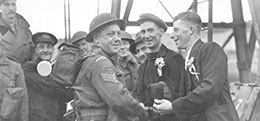
Photo 1
An interesting photo taken on 2 July 1940 the first day most locals would have seen German troops patrolling the Island.
The three soldiers on the left of the photo are a machine gun team heading for Castle Cornet built before 1204 which guards the entrance to St. Peter Port harbour. Deputy Inspector Arthur Langmede on his B.S.A. Motorcycle had been tasked with escorting the two Luftwaffe Pilot Officers around the island.
Note the list of locations held by the officer with the walking stick and the Orders of the Commandants of the German Forces in Occupation of the Bailiwick of Guernsey signed by Major Lanz can be seen in the other officers hand which is the reason for the tour to distribute these orders and fix them in prominent position
Credit:- CIOS
Photo 1
Two Luftwaffe pilots ask a Police Motorcyclist for directions on the Castle Emplacement, St. Peter Port, Guernsey.
Click Photo to Read More






